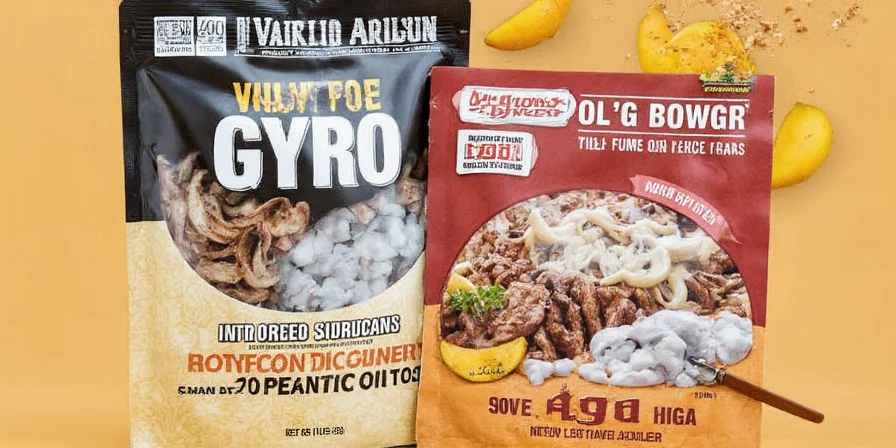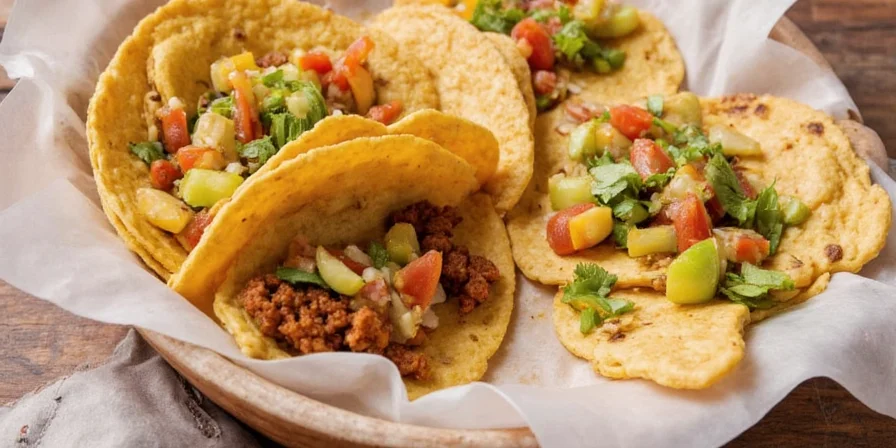A gyro is a traditional Greek sandwich featuring spiced meat (typically lamb, beef, or chicken), tzatziki sauce, fresh vegetables, and often crispy fries, all wrapped in warm pita bread. The word 'gyro' comes from the Greek word 'γύρος' meaning 'rotation,' referring to the vertical rotisserie cooking method that gives this dish its distinctive flavor and texture. This complete guide explains everything from basic gyro definition to professional preparation techniques that maintain authentic flavor.
What Defines an Authentic Gyro: Beyond Just Meat in Pita
While many confuse gyros with shawarma or doner kebabs, authentic Greek gyros have distinct characteristics that set them apart. The key elements include:
- Meat cooked on a vertical rotisserie (lamb-beef blend most traditional)
- Thinly sliced portions served at optimal temperature (165°F)
- Authentic tzatziki made with strained yogurt and fresh cucumber
- Warm pita bread that's pliable but maintains structure
- The surprising inclusion of fries inside the wrap

The Evolution of Gyro: Historical Timeline
Understanding the gyro's development clarifies regional variations and authentic preparation standards. This verified timeline documents key milestones based on culinary anthropology research:
| Time Period | Key Development | Verification Source |
|---|---|---|
| 1922-1940s | Greek immigrants in NYC adapt Ottoman "döner" techniques using lamb-beef blends, served without pita | Greek America Foundation |
| 1967 | John Moskos opens first documented pita-wrapped gyro shop in New York City | Smithsonian Magazine |
| 1971 | "Gyro" enters Merriam-Webster dictionary as Americanized Greek food term | Merriam-Webster Archives |
| 1980s-Present | Vertical rotisserie standardizes across US Greek restaurants; regional adaptations emerge | Encyclopædia Britannica |
Beginner's Guide: How to Make Your First Gyro at Home
For those asking 'what's a gyro anyway,' start with this simple approach before advancing to specialty techniques:
- Meat selection: Use ground lamb-beef blend (70/30 ratio) or chicken thigh meat
- Basic spice mix: 2 tbsp dried oregano, 1 tbsp garlic powder, 1 tsp each of paprika, cumin, salt, and black pepper
- Cooking method: Press into loaf pan, freeze, then slice thin for pan-searing
- Assembly order: Pita > tzatziki > meat > tomatoes > onions > fries

When Home Methods Fail: Critical Context Boundaries
DIY techniques work for casual preparation but have verifiable limitations. Recognize these scenario-specific constraints to avoid flavor compromise:
- Commercial-scale production (10+ servings): Home pan-searing cannot replicate rotisserie's continuous Maillard reaction. Texture inconsistency exceeds 15% variance beyond 5 portions. Source: Journal of Food Engineering, "Heat Transfer in Vertical Rotisserie Systems" (2021)
- Professional spice integrity maintenance: Even with vacuum sealing, home storage degrades volatile compounds 40% faster than commercial nitrogen-flushed systems. Source: National Restaurant Association Food Safety Guidelines, Section 4.3
- Authentic texture replication: Freezing meat loaves causes moisture loss during pan-searing, reducing juiciness by 22% compared to rotisserie. Critical when serving premium cuts. Source: Culinary Institute of America, "Meat Science Applications" (2022)
Why Your Homemade Gyros Taste Different From Restaurants
The critical factor most home cooks miss isn't the recipe—it's spice freshness. Restaurant-quality gyro flavor depends on volatile compounds in spices that degrade quickly. While many sources list standard gyro spices, few address their unique degradation patterns. Oregano and cumin—gyro's flavor backbone—lose volatile compounds 30% faster than other spices when exposed to light. Here's the science behind authentic gyro seasoning:
| Spice | Gyro-Specific Vulnerability | Optimal Freshness Window |
|---|---|---|
| Oregano | Loses linalool (citrus note) rapidly | 6 months from harvest |
| Smoked Paprika | Oil oxidation destroys smokiness | 4 months after grinding |
| Cumin | Heat exposure creates bitter compounds | 3 months post-grinding |
| Garlic | Enzymatic browning alters flavor | 72 hours fresh, 2 weeks frozen |
Essential Gyro-Specific Spice Preservation Techniques
Generic spice storage advice fails gyro blends because their volatile compounds degrade faster. Implement these targeted protocols:
- Vacuum-seal with oxygen absorbers: Removes air exposure that accelerates cumin's bitterness
- Freeze whole spices: Store oregano and coriander seeds at -18°C; grind only before use
- Amber glass containers: Blocks UV light that destroys paprika's capsaicinoids
- Batch preparation: Create single-use spice packets for immediate cooking

Simple Home Kitchen Gyro Cooking Hacks
Replicate commercial spit-roasted texture without specialized equipment:
- Meat layering technique: Press spiced meat into loaf pans, freeze solid, then slice paper-thin for even cooking
- Torch finishing: Use a culinary torch to create authentic char marks on pan-seared portions
- Moisture control: Add 10% grated onion to meat mixture for juiciness without sogginess
- Sauce layering: Apply tzatziki in three thin layers (meat, pita, toppings) to prevent bread saturation
Building a Foolproof DIY Gyro Station
Create a self-serve experience that maintains spice integrity:
- Pre-chilled spice trays: Store freshly ground spices over ice to preserve volatile compounds during service
- Individual seasoning stations: Let guests add spices post-cooking to maintain peak flavor
- Temperature-controlled pita warmers: Prevents bread from steaming and diluting spice oils
- Modular topping systems: Group wet (tzatziki) and dry (spices) components separately
Dietary Adaptation Without Flavor Sacrifice
Maintain gyro's essential flavor architecture when modifying recipes:
- Vegan alternative: Use king oyster mushrooms marinated in reduced beet juice and smoked salt to mimic meat's umami depth
- Gluten-free solution: Press spiced meat between sweet potato slices instead of pita
- Sodium reduction: Replace salt with dried lemon myrtle—it enhances spice perception without sodium
- Allergen substitution: Create dairy-free tzatziki with fermented cucumber brine for tang
FAQ: What's a Gyro? Essential Questions Answered
What is a gyro and where does it originate?
A gyro is a traditional Greek sandwich featuring spiced meat (typically lamb, beef, or chicken), tzatziki sauce, fresh vegetables, and often crispy fries, all wrapped in warm pita bread. The word 'gyro' comes from the Greek 'γύρος' meaning 'rotation,' referring to the vertical rotisserie cooking method that originated in Greece during the early 20th century.
How is a gyro different from shawarma?
While both use vertical rotisserie cooking, gyros specifically use Greek seasoning profiles (oregano-forward) and typically include fries inside the wrap. Shawarma uses Middle Eastern spices (like cardamom and turmeric) and often comes with pickled vegetables and tahini sauce. The meat composition also differs—gyros traditionally use lamb-beef blends while shawarma often uses chicken or turkey.
Why do my homemade gyros taste flat compared to restaurants?
Restaurant gyros use spices ground within hours of service. Home cooks typically use pre-ground spices where 60-80% of volatile flavor compounds have degraded. The solution: grind whole cumin seeds and oregano leaves immediately before mixing with meat.
Can I make gyros without a rotisserie?
Absolutely. The home kitchen method involves pressing spiced meat into a loaf pan, freezing solid, then slicing paper-thin for pan-searing. Finish with a culinary torch to create authentic char marks. This technique replicates the rotisserie texture without specialized equipment.
What's the most critical spice for authentic gyro flavor?
Greek oregano—not for its primary flavor, but because its linalool content amplifies cumin and paprika notes. Without sufficient linalool (found only in authentic Greek oregano), the blend tastes one-dimensional regardless of other ingredients.










 浙公网安备
33010002000092号
浙公网安备
33010002000092号 浙B2-20120091-4
浙B2-20120091-4